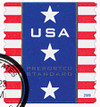
# 4385 - 2009 10c Patriotic Banner coil stamp, perf 9 3/4 vert
Patriotic Banner
Issue Date: February 24, 2009
City: Washington, D.C.
Known popularly as “the Stars and Stripes,” the American flag symbolizes the strength and unity of the nation’s citizens. Flying gently from the porch of a Main Street home or carried into battle, the flag has been a source of inspiration and pride throughout America’s history.
Although its exact origins are unknown, the Continental Congress passed the first Flag Act on June 14, 1777. It specified that the flag of the United States be made of thirteen stripes of alternating red and white, with thirteen white stars against a field of blue. The stripes represent the original thirteen colonies, while the stars represent the states of the union. The color red symbolizes hardiness and valor; white represents purity and innocence; blue signals vigilance, perseverance, and justice.
The design of the American flag was changed as the nation grew. In 1818, President Monroe signed the Act of April 4, 1818, which formally provided for 13 stripes and one star for each state, to be added to the U.S. flag on the 4th of July following the admission of each new state.
As the most pervasive symbol of American ideals, this simple design has the power to comfort in times of grief, inspire loyalty, and rally citizens to its defense. The pattern and colors of the American flag can be seen duplicated on a number of items including clothing, banners, uniforms, and even lawn furniture.
Patriotic Banner
Issue Date: February 24, 2009
City: Washington, D.C.
Known popularly as “the Stars and Stripes,” the American flag symbolizes the strength and unity of the nation’s citizens. Flying gently from the porch of a Main Street home or carried into battle, the flag has been a source of inspiration and pride throughout America’s history.
Although its exact origins are unknown, the Continental Congress passed the first Flag Act on June 14, 1777. It specified that the flag of the United States be made of thirteen stripes of alternating red and white, with thirteen white stars against a field of blue. The stripes represent the original thirteen colonies, while the stars represent the states of the union. The color red symbolizes hardiness and valor; white represents purity and innocence; blue signals vigilance, perseverance, and justice.
The design of the American flag was changed as the nation grew. In 1818, President Monroe signed the Act of April 4, 1818, which formally provided for 13 stripes and one star for each state, to be added to the U.S. flag on the 4th of July following the admission of each new state.
As the most pervasive symbol of American ideals, this simple design has the power to comfort in times of grief, inspire loyalty, and rally citizens to its defense. The pattern and colors of the American flag can be seen duplicated on a number of items including clothing, banners, uniforms, and even lawn furniture.
















